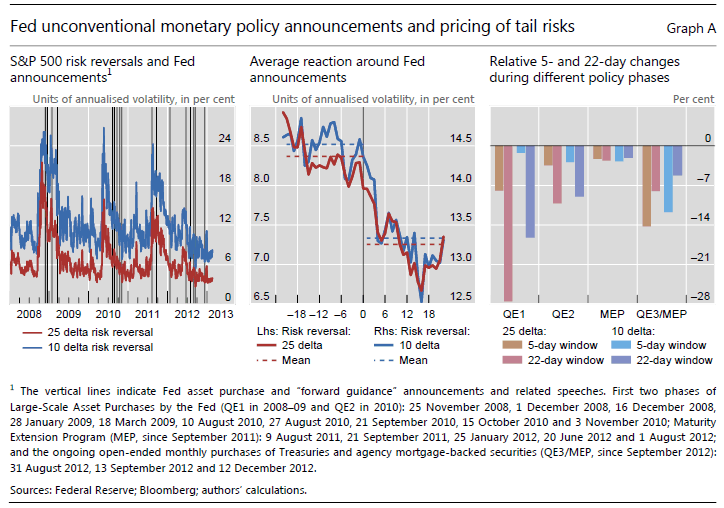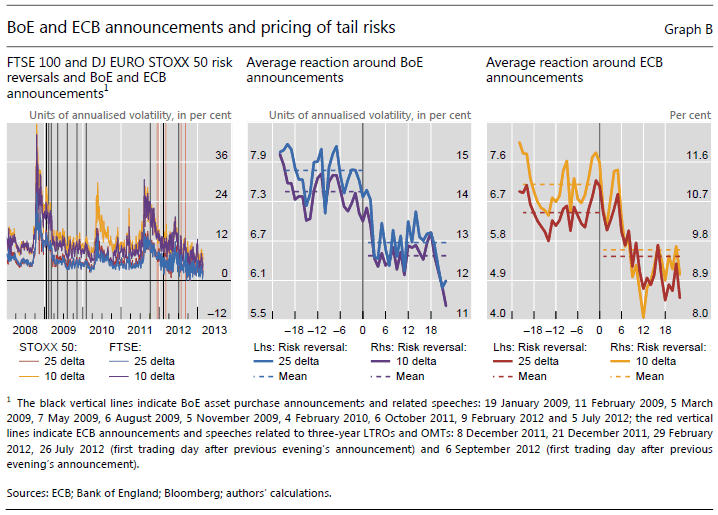Tail-risk perceptions around unconventional monetary policy announcements
(Extract from pages 4-5 of BIS Quarterly Review, March 2013)
Unconventional policy actions by various central banks over the past few years are perceived to have helped (at least partly) alleviate some of the most immediate downside risks to financial markets and the global economy.1 Any evidence on what may be labelled the "tail risk impact" of unconventional monetary policy has, however, largely been anecdotal. In this box, we present quantitative evidence which suggests that announcements related to unconventional monetary policy measures substantially reduced market perceptions of tail risks. Hence, the impact of these policies may in fact have been broader than suggested by existing studies, which focused on the effects of quantitative easing (QE) on the shape of the yield curve, asset prices more broadly and portfolio flows.
We gauge downside risk perceptions using information gleaned from option prices. Specifically, we rely on the difference between the option-implied volatilities of out-of-the-money (OTM) puts and OTM calls of the same maturity and "moneyness" (or so-called delta), often referred to as "risk reversal". 2 An OTM option has a strike price distant from the current market price and thus will only be exercised if the price movement over the option's lifetime is sufficiently large. Since equity returns are typically negatively skewed, ie steep price falls are more likely than steep rises, OTM puts are more likely to be exercised than OTM calls. As a result, the price of OTM puts (or, equivalently, their implied volatility) is higher. This is further compounded when investors may expect large losses, consequently demanding high risk premia to compensate them for such tail events. The difference in the two implied volatilities is thus magnified in stress episodes when hedging costs against downside risk are particularly elevated (Graph A, left-hand panel). Therefore, risk reversals can be an informative indicator of how market participants perceive the risk of a severe stock market crash. This differs from the VIX, a commonly used "fear gauge", which does not specifically capture downside risks, as it is a symmetrical measure of expected volatility.3
To capture the impact of unconventional monetary policy on risk reversals, we compare their levels over an event window of several trading days before and after key announcements. The tail risk measures dropped by 10% on average around 18 unconventional monetary policy announcements by the US Federal Reserve (Graph A, centre panel). As the graph shows, there is an immediate drop of risk perceptions following the announcements and the effect is sustained for some time, with risk reversals on average lower at five-day and longer horizons.4
Risk perceptions were affected more strongly during the first round of unconventional policies, especially around QE1 announcements (Graph A, right-hand panel). The impact of subsequent announcements associated with QE2 and early phases of the Maturity Extension Program (MEP) was more subdued. Fed announcements appear to have been curbing tail risk perceptions once again during the ongoing phase of QE3. The resumption of a stronger impact of Fed announcements may be best understood by appealing to a framework whereby central bank purchases can provide insurance against tail events, if accompanied by clear communication and a commitment to condition policy actions on future states of the economy.5 Hence, the Fed's use of "forward guidance" and the communication of employment targets for asset purchases may have enhanced the effect of MEP and of QE3.6
Announcements by other central banks may have reduced tail risk perceptions as well. Asset purchase announcements by the Bank of England (BoE) had qualitatively similar effects (Graph B, centre panel). The more sluggish reaction to the recent ECB announcement suggests differences in the transmission of ECB policies, namely three-year longer-term refinancing operations (LTROs) and outright monetary transactions (OMTs), as compared with outright asset purchase announcements by the Fed and the BoE (Graph B, right-hand panel).
1 See eg Olivier Blanchard, "(Nearly) nothing to fear but fear itself", The Economist, 29 January 2009; speech by Fed Chairman Ben Bernanke at the Jackson Hole Symposium, 31 August 2012; and BIS, 82nd Annual Report, June 2012.
2 The delta of an option measures the sensitivity of its price to changes in the price of the underlying. Lower delta options (eg 10 delta) have a strike more distant from the current price and are thus deeper OTM options.
3 We report absolute values of risk reversals, such that a higher value corresponds to a higher price of crash risk insurance.
4 In M Hattori, A Schrimpf and V Sushko, "The response of tail risk perceptions to quantitative easing", 2013, mimeo, we conduct some more detailed analysis. Based on a bootstrap approach, we find that changes in risk reversals around Fed announcement dates are statistically significant, with effects stronger relative to simple volatility measures. We also control for other factors driving risk perceptions using event study regressions and examine the effects of actual asset purchases in structural vector autoregression frameworks.
5 See M Brunnermeier and Y Sannikov, "Redistributive monetary policy", paper prepared for the 2012 Jackson Hole Symposium.
6 The mechanism may operate by improving the capital position of value-at-risk (VaR)-constrained financial institutions, as Fed purchases affect the market value of their fixed income and possibly other asset holdings. A lower likelihood of hitting the VaR constraint may lead to repricing of risks and raise risk appetite, as in H S Shin, Risk and liquidity, Oxford University Press, 2010. Seealso C Borio and H Zhou, "Capital regulation, risk-taking and monetary policy: a missing link in the transmission mechanism", BIS WorkingPapers, no 268, December 2008, for a discussion of monetary policy transmission via financial intermediary balance sheets and risk spreads.




